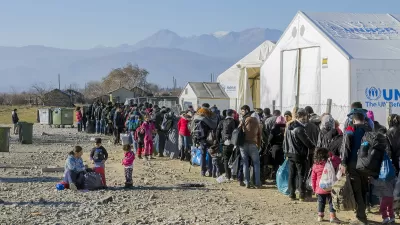To ease the transition from conflict into post-conflict and stability, there is a high need for urban professionals who can artfully balance the demand for security alongside city spaces for healing, argues Mitchell Sutika Sipus.
Today, the world is dotted by low-intensity protracted conflicts, stretching onward by scattered acts of terrorism and insurgency, thus continually threatening civil society and undermining the development of state sponsored institutions. The elongation of war not only drains state resources, but reinforces a cyclical condition of violence, as the population subjected to war must continue to live and die in a constant state of fear and aggression. Unfortunately in these conditions, the triggers of trauma do not go away, making it nearly impossible for local populations to leave behind painful memories and to move forward in their lives.
While contemporary psychology may have individual methods of therapy, tied to the personal history of the victim, there is a clear demand to move forward at an urban scale. While there remains risks, a city consisting of fortified defensive walls and military installations is not a city where one wants to live. Yet at what point do the walls come down? If there is to be a sufficient transition in contemporary warfare from conflict to truly post-conflict, then urban professionals must take it upon themselves to facilitate this change to create infrastructure that meets the immediate demands of security with the long-term demands of healing.
FULL STORY: Demand for Urban Planners to Heal the Trauma of War

Alabama: Trump Terminates Settlements for Black Communities Harmed By Raw Sewage
Trump deemed the landmark civil rights agreement “illegal DEI and environmental justice policy.”

Planetizen Federal Action Tracker
A weekly monitor of how Trump’s orders and actions are impacting planners and planning in America.

The 120 Year Old Tiny Home Villages That Sheltered San Francisco’s Earthquake Refugees
More than a century ago, San Francisco mobilized to house thousands of residents displaced by the 1906 earthquake. Could their strategy offer a model for the present?

Opinion: California’s SB 79 Would Improve Housing Affordability and Transit Access
A proposed bill would legalize transit-oriented development statewide.

Record Temperatures Prompt Push for Environmental Justice Bills
Nevada legislators are proposing laws that would mandate heat mitigation measures to protect residents from the impacts of extreme heat.

Downtown Pittsburgh Set to Gain 1,300 New Housing Units
Pittsburgh’s office buildings, many of which date back to the early 20th century, are prime candidates for conversion to housing.
Urban Design for Planners 1: Software Tools
This six-course series explores essential urban design concepts using open source software and equips planners with the tools they need to participate fully in the urban design process.
Planning for Universal Design
Learn the tools for implementing Universal Design in planning regulations.
Clanton & Associates, Inc.
Jessamine County Fiscal Court
Institute for Housing and Urban Development Studies (IHS)
City of Grandview
Harvard GSD Executive Education
Toledo-Lucas County Plan Commissions
Salt Lake City
NYU Wagner Graduate School of Public Service



























